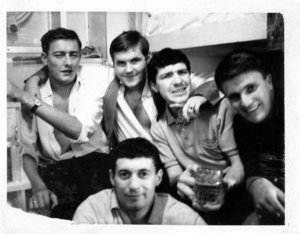- Joined
- Jun 30, 2012
- Messages
- 1,418
- Points
- 433

 |
As a way to introduce our brass coins to the community, we will raffle off a free coin during the month of August. Follow link ABOVE for instructions for entering. |
 |
 |
The beloved Ships in Scale Magazine is back and charting a new course for 2026! Discover new skills, new techniques, and new inspirations in every issue. NOTE THAT OUR FIRST ISSUE WILL BE JAN/FEB 2026 |
 |


I remember those valves/tubes. I only briefly had a radio amateur license. When I was sailing in the small passenger liner RMS St. Helena, I was able to purchase one on the island for £5. My call sign was ZD7RW, but of course it wasn't valid in the UK, and I wasn't going to take an exam in the UK, feeling that my professional 1st Class PMG should have been good enough! It was the PMG that issued the amateur license as well, that made it all the more ridiculous! I used a small home-made Tx on 14,060 Mhz, CW only, and once got QSL at 6,000 miles, South Atlantic Ocean to Panama! This was the sort of ship I sailed in when younger, RMS Windsor Castle, 36,000 tons. 250 first class passengers and 600 tourist. Sailed in her for 5 years as 4th radio officer, then 3rd, and finally 2nd. Other image shows me repairing the main radar when I was 2nd in 1972!
View attachment 120107 View attachment 120106

You might want to check this topic!What a great and informative post Bob. I really enjoy seeing other modelers workbenches, but this must be the neatest one. Mine is just the opposite . Seeing the varied tools, glues and "stuff" used is a learning experience and always fun.View attachment 120852

I love it! How poor would the world be without us "eccentrics" who know things.The four switches (each with a red neon lamp over them) are the power control system. 1 turns on the desk light. 2 turns on a CD player, 3 turns on a variable DC power unit, and 4 turns on the power sockets on the right of the desk (out of the picture). The lights ensure that I don't inadvertanly leave anything on when I finish. Next to that is a small square black panel that has an aerial, earth and loudspeaker sockets with a switch where I can select the loudspeaker input (matched for 3 ohms, or via a matching transformer). Above it is a small brown panel with the output sockets for the variable power unit Next to that is the variable power unit on the bottom with a control that allows me to select any DC voltage for 0 Volts to 300 Volts. Above it is a loudspeaker connected to aerial/earth/speaker panel. Above the small square panel is a test meter connected to the variable power supply, so I can set whatever number of Volts I require. The box with the large round hole in it is empty, and has now been disposed of. I sometimes experiment with the design and construction of obsolete valve (or "tube" as you call them in the US) radios (I was a ship's radio officer at sea for over 30 years), so I like to have aerial, earth, loudspeaker and power supplies handy at the flick of a switch. Here is a radio that I designed and built. The valves (tubes) are about 90 years old, and it all works very well - Bob
View attachment 120091
As a new member reading the posts I came across your valve receiver. Your receiver is a superb work of art.The four switches (each with a red neon lamp over them) are the power control system. 1 turns on the desk light. 2 turns on a CD player, 3 turns on a variable DC power unit, and 4 turns on the power sockets on the right of the desk (out of the picture). The lights ensure that I don't inadvertanly leave anything on when I finish. Next to that is a small square black panel that has an aerial, earth and loudspeaker sockets with a switch where I can select the loudspeaker input (matched for 3 ohms, or via a matching transformer). Above it is a small brown panel with the output sockets for the variable power unit Next to that is the variable power unit on the bottom with a control that allows me to select any DC voltage for 0 Volts to 300 Volts. Above it is a loudspeaker connected to aerial/earth/speaker panel. Above the small square panel is a test meter connected to the variable power supply, so I can set whatever number of Volts I require. The box with the large round hole in it is empty, and has now been disposed of. I sometimes experiment with the design and construction of obsolete valve (or "tube" as you call them in the US) radios (I was a ship's radio officer at sea for over 30 years), so I like to have aerial, earth, loudspeaker and power supplies handy at the flick of a switch. Here is a radio that I designed and built. The valves (tubes) are about 90 years old, and it all works very well - Bob
View attachment 120091


